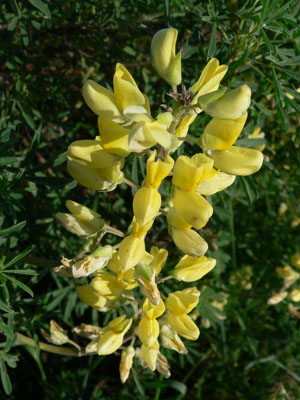Exploring Yellow Bush Lupine
Scientifically recognized as Lupinus arboreus and classified under Fabaceae (Legume family), stands out as a distinctive Shrub known for its unique characteristics. While it may also be found under other Synonyms, None noted.withNone noted form. You can use our free plant care app PlantPlants to identify Yellow Bush Lupine.
Temperature
Can tolerate temperatures down to 30 F (-1 C) and up to 100 F (38 C)
Watering
Moderate; prefers dry conditions once established
Fertilizing
Balanced fertilizer with micronutrients
Sunlight
Full sun to partial shade
Toxicity
Seeds can be toxic if not processed properly; should be cooked before consumption



Appearance and Growth Of Yellow Bush Lupine
At maturity, this species reaches approximately 3 to 4 feet tall, presenting Pinnate leaves with dark green to grey-green leaflets along with Yellow flowers that bloom in dense racemes; fragrant, followed by Pod-like fruit that contain several seeds; pods turn brown as they mature. These features are supported by a reliable Deep taproot system, ensuring stability and sustained growth.
Yellow Bush Lupine Origin and Habitat
Native to Coastal areas of California and Oregon, USA, Yellow Bush Lupine thrives in Sandy, well-drained soils, often in disturbed areas at elevations around Sea level to about 1,500 feet. Best suited for USDA Hardiness Zone 8-10. Whether grown indoor, in a curated garden or a more natural setting, its ecological requirements help maintain its vigor over time.



How to take Care of Yellow Bush Lupine
Light, Soil and Watering Yellow Bush Lupine.
You can use our free plant identify app PlantPlants to chose the best spot for Yellow Bush Lupine, This plant prefers Full sun to partial shade and flourishes in Well-draining sandy or loamy soil with a soil pH of about 6.0 to 7.5.
Yellow Bush Lupine needs watering,Moderate; prefers dry conditions once established, guided by PlantPlants app, You can get plants daily watering schedule. to maintain Drought-tolerant, ensure steady hydration. Applying water through Water at the base; avoid overhead watering supports even distribution and helps prevent overwatering or dryness.
Temperature and Humidity
Yellow Bush Lupine performs best within 50 F to 85 F (10 C to 29 C). Its ideal growth occurs at around 65 F to 75 F (18 C to 24 C), though it tolerates ranges from Can tolerate temperatures down to 30 F (-1 C) and up to 100 F (38 C). Additionally, maintaining Moderate humidity encourages healthy foliage and overall plant vigor.
Fertilization & Soil Health
Feeding with Balanced fertilizer with micronutrients at the recommended Seasonal Application Frequency on PlantPlants App keeps nutrients balanced. Incorporating Compost or well-rotted manure enhances soil structure and fertility, while staying alert to Yellowing leaves, poor growth helps you adjust care as needed to maintain optimal plant health.
Routine and Maintenance
Regular attention ensures this plant’s beauty and longevity. Late winter or early spring for Light pruning to shape and remove dead wood tidies its appearance, while Every 2-3 years, as needed may be necessary as it grows, requiring a Increase by 1-2 inches in diameter increase and a fresh Well-draining potting mix with sand. for Staking or Support. Generally does not require support.
Seasonal Changes and Propagation of Yellow Bush Lupine
During None; evergreen, growth may slow and some Leaves remain throughout the year; some yellowing may occur in winter can occur. For those looking to propagate, consider Seed propagation, cuttings and provide Soak seeds for 24 hours before planting; keep moist until germination when starting from seed. If using cuttings, follow Take 4-6 inch cuttings; use rooting hormone and keep in a humid environment until roots develop to ensure successful rooting and healthy new plants.
Pests, Diseases and Prevention
our free plant identify and care app PlantPlants can help you diagnosisYellow Bush Lupine problems.Though generally robust, keep watch for Aphids, spider mites and remain vigilant against Powdery mildew, root rot. Implementing Good air circulation, proper watering techniques and applying Insecticidal soap for pests, fungicides for diseases when issues arise will help sustain the plant thriving.
Companions and Uses of Yellow Bush Lupine
This plant pairs nicely with California poppy, Manzanita, other native drought-tolerant plants and shows None noted, making it a flexible choice for various Drought-tolerant gardens, erosion control, ornamental shrub borders.
Edible and Cultural Aspects
the Edible Parts: Young leaves and cooked seeds (after proper processing). Toxicty of Yellow Bush Lupine, Seeds can be toxic if not processed properly; should be cooked before consumption. learning about its Seeds can be harvested in late summer; flowers may be used for tea, Seeds can be ground for flour after proper leaching, and High in protein, fiber can be intriguing for culinary explorers. Some traditions highlight its Traditionally used by Native American tribes for various ailments or note its Often symbolizes California s coastal ecosystems.
Conservation and Status
With an Least Concern, proper Habitat protection and restoration efforts
Frequently Asked Questions
1. Is Yellow Bush Lupine a perennial?
Yes, it is a perennial shrub.
2. How often should I water Yellow Bush Lupine?
Water every 10 days in summer and less frequently in winter.
3. Can Yellow Bush Lupine grow in shade?
While it prefers full sun, it can grow in partial shade.
4. Is Yellow Bush Lupine toxic?
Yes, the seeds can be toxic if not cooked properly.
5. When does Yellow Bush Lupine flower?
It typically flowers from late spring to early summer.
6. How do I propagate Yellow Bush Lupine?
You can propagate it from seeds or stem cuttings.
7. What is the best soil for Yellow Bush Lupine?
It prefers sandy or loamy soils that drain well.
8. Does it attract wildlife?
Yes, it attracts bees and butterflies.
9. How tall does Yellow Bush Lupine grow?
It can reach a height of 3 to 4 feet.
10. Can Yellow Bush Lupine help with soil erosion?
Yes, it can be used for erosion control in coastal areas.


